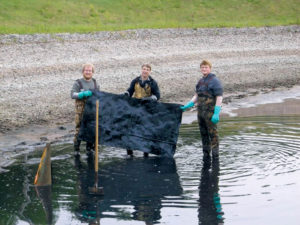
More than 20 years ago, the founders of the PVC Geomembrane Institute (PGI) and the succeeding entity, the Fabricated Geomembrane Institute (FGI) set out to test materials that were in actual field use. They wanted to exhume numerous samples for testing on a periodic basis without ruining the integrity of the installed primary liner system. The Minnesota Department of Natural Resources (MnDNR) became a partner, and at a MnDNR settling basin near the town of Hibbing, Minn., the long-term durability study was initiated in 1995.
The ongoing project’s main objective is to investigate the 30-year durability of PVC geomembranes and PVC chemical fusion and hot wedge welded seams. In October 1995, three 30-mil geomembranes from three different manufacturers were placed at the bottom of a double-lined mine settling basin at a reclamation site near Hibbing, in northern Minnesota’s Mesabi Iron Range.
The weather extremes and the harsh winters with freeze/thaw provided an excellent place to really test the durability of the materials. The settling basin contains mine drainage that was neutralized with magnesium hydroxide. Three PVC test strips, originally 6ft wide and 50ft long, were installed. After exhumations and sampling events after 2, 4, 5, 10, and 20 years, the tests strips are shorter now but still buried below a 6–12in. sand cover at the bottom of the basin. Each test strip contains a single seam that runs the entire length at the centerline of the strip. Two of the strips have chemical seams and the other has a 1.5-in. single wedge-welded seam.
Geomembrane samples were previously collected after years 2, 4, 5, and 10 in the basin. On May 25, 2016, the 20-year samples were retrieved by the author. Samples are being tested at the FGI’s laboratory at the University of Illinois at Urbana-Champaign (UIUC).
Additional sample cutting is planned for the 25- and 30-year marks. Tests are conducted using in situ water content and desiccated specimens and include tensile properties, tear resistance, low temperature/brittleness temperature, dimensional stability, water extraction, and volatile loss. The resulting properties are compared to the initial material specification to quantify any changes in the engineering properties over 20 years.
Tim Stark is a professor of civil engineering at the University of Illinois/Urbana-Champaign and
is the FGI technical director.
 TEXTILES.ORG
TEXTILES.ORG


